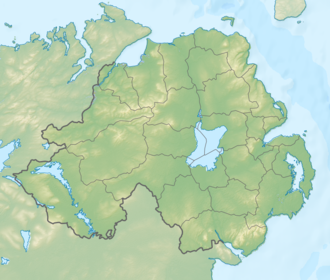| Drumkeeragh Forest | |
|---|---|
 | |
| Map | |
| Geography | |
| Location | Down,Northern Ireland,United Kingdom |
| Coordinates | 54°21′06″N5°56′45″W / 54.351599°N 5.9458209°W |
| Elevation | 190 metres (620 ft) to 310 metres (1,020 ft) |
| Area | 179.81 hectares (444.3 acres) |
| Administration | |
| Governing body | Forest Service Northern Ireland |
Drumkeeragh Forest is a mixed coniferous forest located on the lower slopes of Slieve Croob, near Ballynahinch, Northern Ireland. It is used for commercial felling and is managed by the Forest Service Northern Ireland. [1]
Contents
The forest is predominantly made up of sitka spruce but Norway spruce, western red cedar, European larch, Douglas fir, noble fir, and Scots, lodgepole and Corsican pines are also found there. The trees are felled for timber, with cleared sections rotating every 50 years. The high elevation (190 metres (620 ft) to 310 metres (1,020 ft)) and poor soil mean that deciduous trees used to produce timber can not grow in the forest. [1]
In the cleared areas, replanting has been carried out with wildlife conservation and landscaping in mind. Some of the replanted trees have included mountain ash and silver birch, both native broadleaf trees, which has led to a wider variety of birds in these areas. [1]
